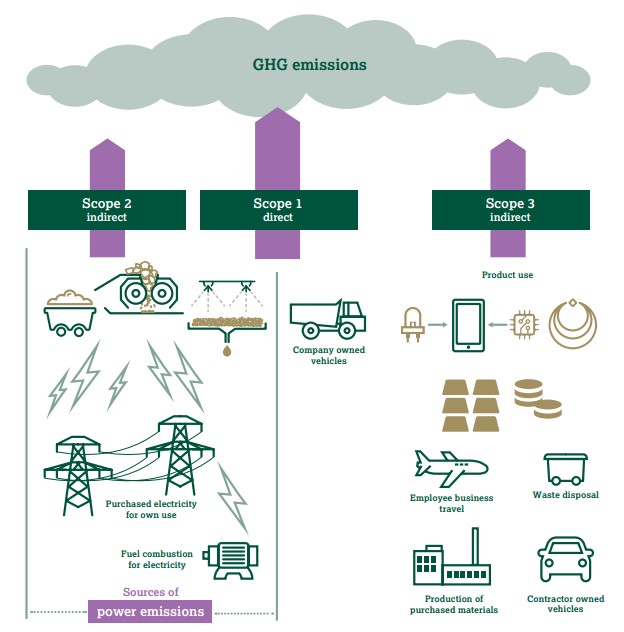Integrate Climate Change into Your Business Strategy
In this section, we will delve into the significance of integrating climate change into your business strategy. As we will elaborate on later, the precious metals sector is notably energy-intensive, particularly during the extraction phase. In a world increasingly cognizant of the imperative to address the climate crisis, it is imperative for companies to assume an active role in curbing greenhouse gas emissions and adapting to climate change.
Why Integrate Climate Change into Business Strategy?
Practical Tools for Integrating Climate Change into Business Strategy
TCFD
To better understand the risks and opportunities related to climate change, the Task Force on Climate-related Financial Disclosures (TCFD) provides essential tools. This international initiative, promoted by the G20 and the Financial Stability Board in December 2015, aims to increase and improve organizations’ reporting on climate-related financial information. This helps provide investors with information on companies’ commitments and activities undertaken to mitigate the risks arising from climate change.
For more information: TCFD
If your company wants to support the TCFD, you can fill out the form at the following link: Support TCFD

Carbon footprint
Understanding and Estimating Greenhouse Gas Emissions
A carbon footprint is a parameter used to estimate the greenhouse gas emissions released by a service, product, organization, event, or individual, generally evaluated in terms of tonnes of equivalent CO2 emitted.
Greenhouse gases are all gases that, due to their chemical-physical characteristics, retain a part of the infrared radiation arriving from the sun, causing the greenhouse effect, which contributes to the rise in average global temperatures. The Kyoto Protocol (1997) provided a list of the most relevant greenhouse gases that must be considered in calculating the carbon footprint: carbon dioxide (CO2), methane (CH4), nitrous oxide (N2O), hydrofluorocarbons (HFCs), perfluorocarbons (PFCs), and sulfur hexafluoride (SF6).
The carbon footprint can be used to determine the impacts that emissions have on anthropogenic climate change. The protocol also provided indications on the unit of measurement: the carbon footprint is expressed in tonnes of CO2 equivalent, using carbon dioxide as a reference with a global warming potential (GWP) value of 1.
Different standards exist for reporting the emissions that make up the carbon footprint of your activities, including the GHG Protocol (Greenhouse Gas Protocol), developed by the World Resources Institute (WRI) and the World Business Council for Sustainable Development (WBCSD), and ISO 14064, the series of international standards developed by the International Organization for Standardization (ISO). The choice between these standards depends on your organization’s specific objectives and compliance needs.
When measuring the carbon footprint, several categories are considered, which may vary slightly depending on the method used, but always include Scope 1 (direct emissions), Scope 2 (indirect emissions from electricity), and Scope 3 (other indirect emissions).
Accounting for Scope 3 emissions is often inherently complex. To address this, the International Council on Mining and Metals (ICMM) has released a guide specific to the mining and metallurgical sector. This guide provides mining and metals companies with a consistent approach to calculate and report Scope 3 emissions externally, allowing them to disclose their value chain emissions to improve transparency and accelerate collaborative action to reduce those emissions.
Science Based Targets Initiative (SBTi)
Reporting greenhouse gas emissions is an important step towards understanding your impact and ensuring transparency. However, setting emissions reduction targets validated by the Science Based Targets initiative (SBTi) can offer significant additional benefits.
The Science Based Targets initiative (SBTi) is a collaborative initiative involving various organizations, including the World Resources Institute (WRI), the Carbon Disclosure Project (CDP), the World Wide Fund for Nature (WWF), and the United Nations Global Compact. The main objective of the SBTi is to support companies in setting greenhouse gas (GHG) emission reduction targets in line with climate science to help limit global warming to safe levels.
Companies wishing to set science-based targets must submit their targets to the SBTi for an approval process, which includes evaluating the consistency of the objectives with established scientific and climate guidelines.
Setting science-based targets can lead to better management of climate risks, greater competitiveness in the emerging sustainability market, and increased investor and stakeholder confidence. SBTi fosters collaboration between companies, non-governmental organizations, and other actors to jointly address the challenge of climate change and promote effective actions at a global level.
Our Commitment: Italpreziosi's Climate Strategy
Italpreziosi began integrating climate change into its corporate strategy in 2021 with the first analysis of its carbon footprint. This assessment has been conducted annually, progressively refining its precision. In 2023, we adopted the TCFD approach, leading to a greater understanding of the risks and opportunities related to climate change.
With awareness of our impacts and the associated risks and opportunities, we decided to embark on a path to reduce our footprint and reach net zero by 2050, aligning with the Paris Agreement to limit temperature increases to well below 2°C and possibly no more than 1.5°C compared to pre-industrial levels. By the end of 2024, we will have set targets to reduce our footprint based on climate science validated by SBTi.
Focus on the gold mining industry
To mitigate the potentially catastrophic impacts from climate change, the world needs to urgently reduce the amount of CO2e emitted into the atmosphere. The global economy needs to reduce its emissions to net zero by 2050, in line with the Paris Agreement. This requires all industries to rapidly reduce their dependency on energy derived from fossil fuels.
The World Gold Council has previously identified that the source of most of the greenhouse gas (GHG) emissions from the gold sector are related to gold mining operations. We estimate around 95% of those emissions are associated with purchased power or fuel combustion. Of this, electricity represents the largest source of emissions at the mine site.
Therefore, if gold mining companies replace direct site-generated electricity from diesel, heavy fuel oil (HFO) and coal with grid connectivity and the increased use of renewable energy sources (RES), alongside substantially reduced production from high emission sites, these changes should enable a reduction in industry power emissions that is clearly aligned with the ‘well below’ 2ºC climate target.
Accelerating and expanding these actions – to replace a substantial amount of power from fossil fuels – will make achievement of Paris-aligned climate targets, including 1.5ºC, feasible.
Not only mining.
the energy used and produced by your company: have you ever thought about renewable energy? Is it already in your energy mix?
supply chain: do you ask information and documents to assess your counterpart ESG strategy? do you do site visit? Do you engage to support your counterparts with raise awareness on the topic?
vehicles: do you have company vehicles? If so, did you consider to substitute your cars with hybrid or electric?
waste disposal: do you have differentiated waste management? Did you create any target to diminish the wastes you produce?
Most important, Human Resources: do you raise awareness within your company?
Do you measure your Co2 emissions? Are you aware of your Carbon Footprint?
Act now
Here a tip to your company, if you want to raise awareness on sustainability and best practices: at Italpreziosi we created our internal annual award for the employees “Champion of Sustainability“. It is open just to our employees and at the end of the year the name of the winner is released internally.
Why don’t you create your own company “Champion of Sustainability Award”. How? Tell your employees to:
– download the Aworld app!
– start following all the challenges they find in the app and accumulate as many points as possible!

QR code to download Google Play

QR code to download App Store

Through the contents of the AWorld app created by the United Nations, your employees will be able to find ideas, videos, interesting tips for everyday life, to always stay on track and become a champion of change!
Your employees will be able to monitor their impact, and create sustainable challenges with their family, loved ones, and especially their children or grandchildren, who represent the new generation!
The carbon offset of your employees will be also possible to be considered in the carbon footprint analysis!
Are you an SME?
We are preparing a Supply chain Climate and Nature Plan for SMEs, stay tuned and register to our newsletter
To find more resources visit



